Medical Equipment Manufacturer Financial Model
This 5-Year, 3-Statement Medical Equipment Manufacturer Financial Model in Excel with revenue from 40 and 80 product lines. Cost structures for revenues and expenditure, and financial Model template statements to forecast the financial health of your Equipment Manufacturing.
Financial Model for a Medical Equipment Manufacturer
A financial model for a medical equipment manufacturer is a structured framework used to project financial performance, analyze profitability, assess cash flow needs, and evaluate capital requirements. It typically includes three primary financial statements:
- Income Statement – Measures profitability.
- Cash Flow Statement – Tracks cash inflows and outflows.
- Balance Sheet – Provides a snapshot of assets, liabilities, and equity.
Additionally, key assumptions, revenue drivers, cost structures, and capital expenditures play a vital role in forecasting.
Income Statement (Profit & Loss Statement)
This section outlines the revenue, expenses, and profitability of the business over a specific period.
Revenue
- Product Sales Revenue: Revenue from selling medical equipment (e.g., imaging machines, surgical tools, patient monitors).
- Service Revenue: Income from after-sales services such as maintenance, repairs, and calibration.
- Software & Subscription Fees: If the company offers software integration, licensing, or cloud-based monitoring.
- Other Revenue Streams: Grants, government subsidies, licensing fees, or R&D partnerships.
Cost of Goods Sold (COGS)
- Raw Materials & Components: Cost of medical-grade plastics, metals, circuits, and sensors.
- Manufacturing & Assembly Costs: Labor, machine usage, and production overhead.
- Quality Control & Compliance Testing: Ensuring regulatory standards (e.g., FDA, CE certification).
- Freight & Distribution Costs: Logistics and transportation expenses.
Gross Profit = Revenue – COGS
- Gross Profit Margin: Key metric indicating profitability at the production level.
Operating Expenses (OPEX)
- Research & Development (R&D): Cost of innovation, clinical trials, and product testing.
- Sales & Marketing: Advertising, promotions, sales team salaries, and trade shows.
- General & Administrative (G&A): Office rent, utilities, salaries of executives and support staff.
- Regulatory & Compliance Costs: Certifications, legal fees, and audits.
Operating Profit (EBIT) = Gross Profit – Operating Expenses
Other Income & Expenses
- Interest Expense: Loan repayments for manufacturing facilities or R&D financing.
- Depreciation & Amortization: Wear and tear on manufacturing equipment and patent amortization.
- Taxes: Corporate tax obligations.
Net Income = EBIT – Interest – Taxes
- Net Profit Margin: Percentage of total revenue retained as profit.
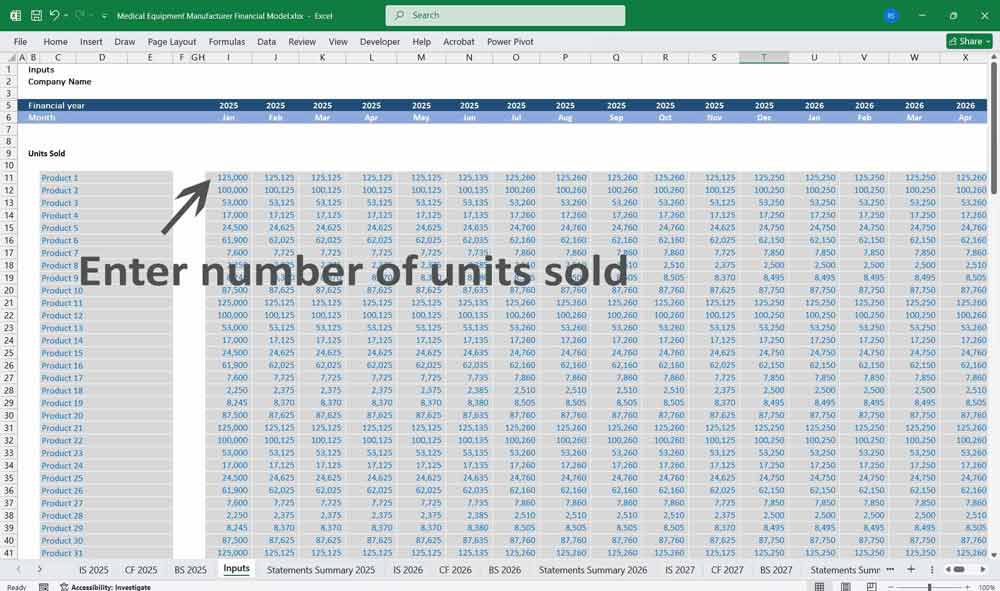
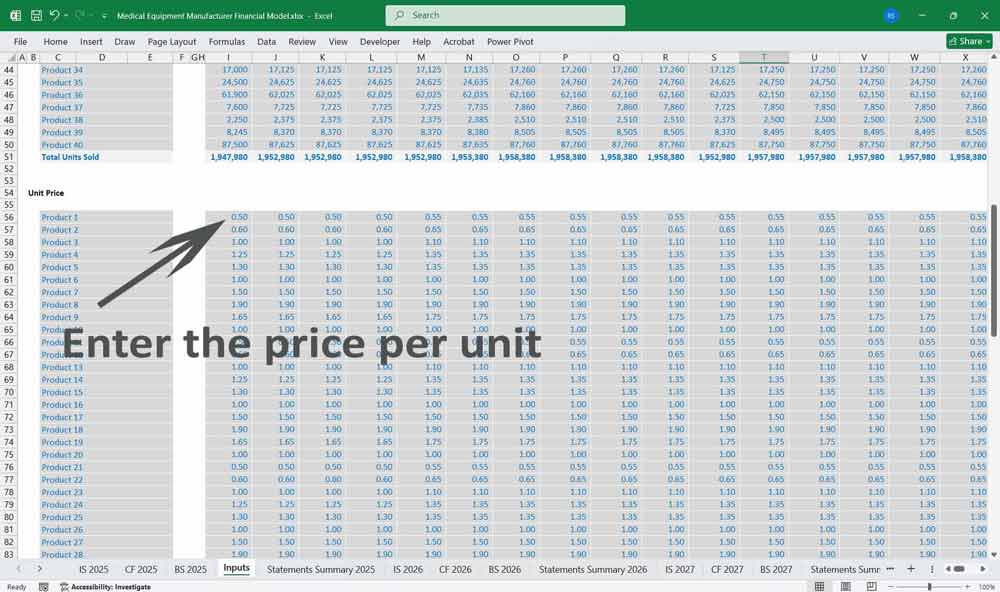


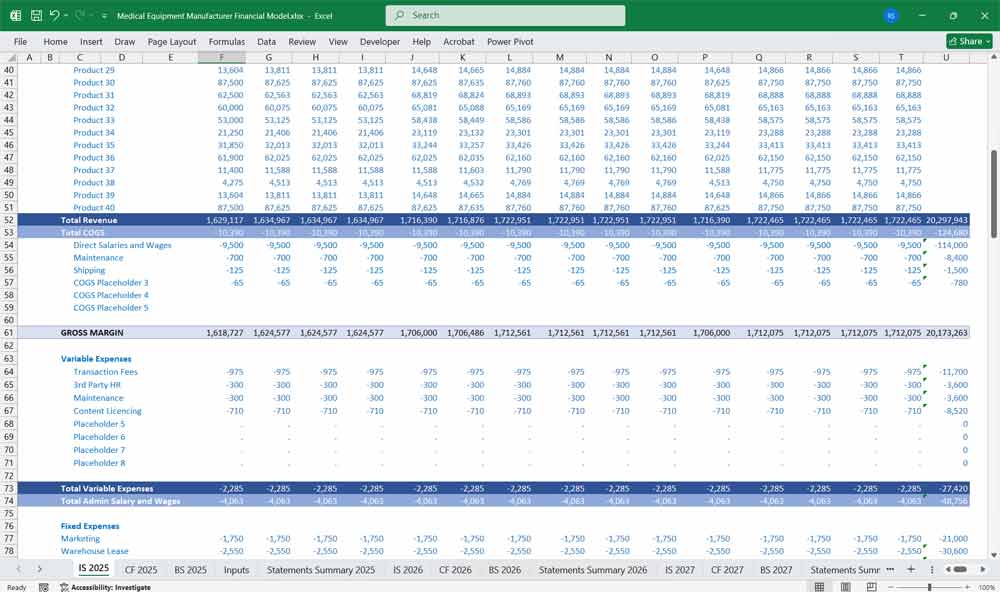
Medical Equipment Manufacturer Cash Flow Statement
Tracks the movement of cash into and out of the business to assess liquidity.
Cash Flow from Operating Activities (CFO)
- Net Income (from the Income Statement).
- Adjustments for Non-Cash Items:
- Depreciation & Amortization.
- Stock-based compensation (if applicable).
- Changes in Working Capital:
- Inventory Changes: Raw materials and finished goods.
- Accounts Receivable: Payment collection from customers.
- Accounts Payable: Payments to suppliers and vendors.
Cash Flow from Investing Activities (CFI)
- Capital Expenditures (CapEx): Purchase of manufacturing equipment, R&D facilities.
- Investment in Technology & Software: Automation, ERP systems, and AI-driven diagnostics.
- Acquisition or Licensing of Patents.
Cash Flow from Financing Activities (CFF)
- Debt Issuance or Repayment: Bank loans, bond financing.
- Equity Financing: Issuing shares, venture capital investments.
- Dividend Payments: If distributing profits to shareholders.
Net Cash Flow = CFO + CFI + CFF
- Ending Cash Balance: Determines available liquidity for future investments and operations.

Medical Equipment Manufacturer Balance Sheet
A snapshot of financial position at a specific point in time.
Assets
Current Assets
- Cash & Cash Equivalents: Operational liquidity.
- Accounts Receivable: Pending payments from customers.
- Inventory: Raw materials, work-in-progress, finished goods.
- Prepaid Expenses: Insurance, rent, vendor deposits.
Non-Current Assets
- Property, Plant & Equipment (PP&E): Manufacturing facilities, warehouses.
- Intangible Assets: Patents, trademarks, software licenses.
- Long-Term Investments: Joint ventures, strategic partnerships.
Liabilities
Current Liabilities
- Accounts Payable: Supplier payments.
- Short-Term Loans: Working capital financing.
- Accrued Expenses: Wages, tax obligations, rent.
Long-Term Liabilities
- Long-Term Debt: Bank loans, bonds, venture capital funding.
- Deferred Revenue: Prepaid service contracts, software subscriptions.
Equity
- Common Stock: Investor funding.
- Retained Earnings: Profits reinvested into the business.
- Shareholder Equity = Assets – Liabilities
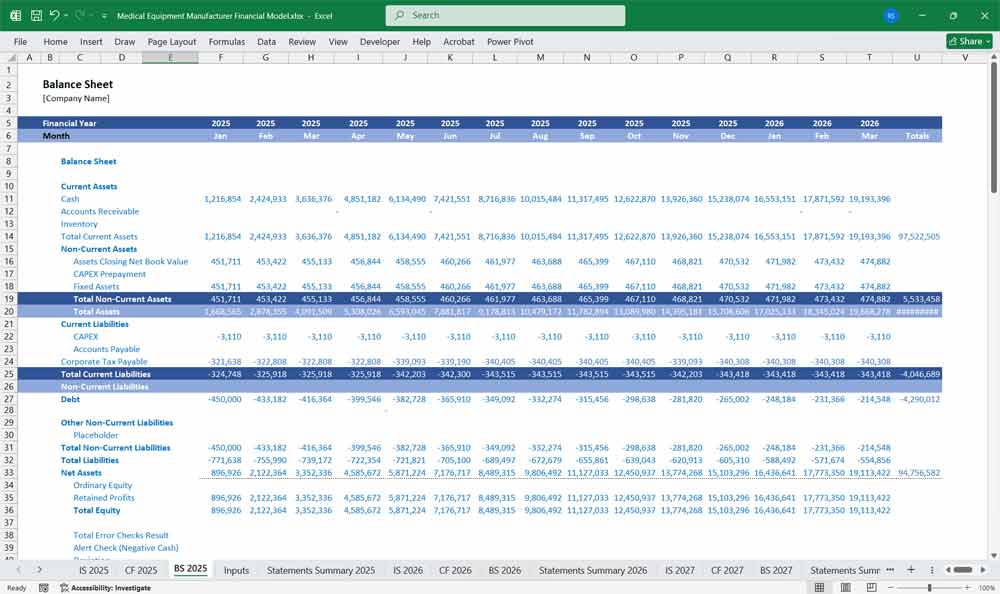
Key Financial Metrics for a Medical Equipment Manufacturer
- Gross Profit Margin = (Gross Profit / Revenue) × 100
- Operating Profit Margin (EBIT Margin) = (EBIT / Revenue) × 100
- Net Profit Margin = (Net Income / Revenue) × 100
- Return on Assets (ROA) = (Net Income / Total Assets) × 100
- Return on Equity (ROE) = (Net Income / Shareholder Equity) × 100
- Debt-to-Equity Ratio = (Total Debt / Shareholder Equity)
- Inventory Turnover = (COGS / Average Inventory)
- Days Sales Outstanding (DSO) = (Accounts Receivable / Revenue) × 365
6-tier subscription model for a medical equipment manufacturer
tailore your offerings to meet the diverse needs of healthcare providers, from small clinics to large hospitals. Each tier should provide increasing value, features, and services to justify the higher price points.
Tier 1: Basic Medical Equipment Access
Target Audience: Small clinics, private practices, or startups with limited budgets.
Features:
Access to essential medical equipment (e.g., basic diagnostic tools, portable devices).
Standard warranty coverage (1 year).
Basic customer support (email and phone during business hours).
Limited access to online training resources (e.g., user manuals, troubleshooting guides).
No customization options for equipment.
Monthly or annual subscription with no long-term commitment.
Value Proposition: Affordable entry point for small practices to access reliable medical equipment without significant upfront costs.
Tier 2: Essential Medical Equipment
Target Audience: Growing clinics or mid-sized healthcare facilities.
Features:
All Tier 1 features.
Extended warranty coverage (2 years).
Priority customer support (faster response times, extended hours).
Access to intermediate training resources (e.g., webinars, video tutorials).
Basic equipment customization (e.g., branding, minor modifications).
Discounts on consumables and replacement parts.
Option to upgrade equipment after 12 months.
Value Proposition: Enhanced support and flexibility for clinics looking to scale their operations.
Tier 3: Professional Care Medical Equipment
Target Audience: Established hospitals, specialty clinics, or larger healthcare providers.
Features:
All Tier 2 features.
Comprehensive warranty coverage (3 years) with on-site servicing.
Dedicated account manager for personalized support.
Advanced training resources (e.g., in-person training sessions, certification programs).
Moderate equipment customization (e.g., software integration, ergonomic adjustments).
Discounted rates on premium equipment and accessories.
Access to a shared pool of backup equipment during repairs.
Value Proposition: A professional-grade solution for healthcare providers requiring reliability, customization, and advanced support.
Tier 4: Premium Medical Equipment Solutions
Target Audience: Large hospitals, multi-specialty centers, or regional healthcare networks.
Features:
All Tier 3 features.
Extended warranty coverage (5 years) with 24/7 on-call technical support.
Full equipment customization (e.g., tailored software, hardware modifications).
Exclusive access to beta testing for new equipment and features.
Comprehensive training programs for staff, including train-the-trainer sessions.
Priority access to new product launches and innovations.
Free consumables and replacement parts for the first year.
Value Proposition: A premium offering for large-scale operations that demand cutting-edge technology, customization, and top-tier support.
Tier 5: Enterprise Medical Equipment
Target Audience: National or international healthcare chains, large academic medical centers.
Features:
All Tier 4 features.
Lifetime warranty on all equipment (with annual subscription renewal).
24/7 dedicated support team with on-site technicians available within 24 hours.
Full integration with existing hospital systems (e.g., EHR, IoT platforms).
Customized equipment designs tailored to specific workflows.
Complimentary upgrades to the latest equipment models every 3 years.
Access to exclusive industry events and thought leadership content.
Value Proposition: A bespoke solution for enterprise-level organizations that require seamless integration, lifetime value, and unparalleled support.
Tier 6: Concierge Medical Equipment Service
Target Audience: Ultra-premium clients, such as luxury private hospitals, VIP medical centers, or high-net-worth individuals.
Features:
All Tier 5 features.
White-glove concierge service for equipment selection, installation, and maintenance.
Fully customized equipment designed in collaboration with the client.
Exclusive access to proprietary technologies and innovations.
On-demand training and consulting services for staff.
Complimentary annual equipment audits and performance optimization.
Invitations to exclusive global healthcare summits and networking events.
Value Proposition: The ultimate subscription tier for clients who demand the highest level of personalization, exclusivity, and luxury in medical equipment and services.
Key Considerations for Implementation:
Scalability: Ensure each tier can scale with the client’s growth.
Flexibility: Allow clients to upgrade or downgrade tiers based on their needs.
Transparency: Clearly communicate the benefits and pricing of each tier.
Customer Feedback: Regularly gather feedback to refine and improve the offerings.
Technology Integration: Ensure compatibility with existing healthcare systems and workflows.
Compliance: Adhere to industry regulations and standards for medical equipment and services.
This tiered model ensures that the medical equipment manufacturer can cater to a wide range of clients while maximizing revenue and customer satisfaction.
80-Product Line Scenarios For A Medical Equipment Manufacturer
Diagnostic Imaging Medical Equipment
X-ray Machines
Digital X-ray medical systems
Portable X-ray medical units
MRI Scanners
High-field MRI systems
Open MRI medical scanners
CT Scanners
Multi-slice medical CT scanners
Cone-beam CT systems
Ultrasound Machines
3D/4D ultrasound systems
Portable ultrasound devices
PET-CT Scanners
Hybrid PET-CT systems
Mobile PET-CT medical units
Patient Monitoring Systems
Vital Signs Monitors
Multi-parameter monitors
Wearable vital signs monitoring equipment
ECG Machines
12-lead ECG systems
Portable ECG devices
Pulse Oximeters
Finger pulse oximeters
Handheld pulse oximeters
Fetal Monitors
Wireless fetal monitors
Doppler fetal monitors
Surgical Medical Equipment
Electrosurgical Units
Bipolar electrosurgical medical devices
Monopolar electrosurgical medical systems
Surgical Lasers
CO2 surgical lasers
Diode surgical lasers
Surgical Tables
Hydraulic surgical medical tables
Electric surgical tables
Surgical Lights
LED surgical lights
Mobile surgical medical lights
Anesthesia Medical Equipment
Anesthesia Machines
Portable anesthesia machines
Stationary anesthesia systems
Vaporizers
Desflurane vaporizers
Sevoflurane vaporizers
Ventilators
ICU ventilators
Transport ventilating equipment
Laboratory Medical Equipment
Centrifuges
High-speed centrifuges
Microcentrifuges
Blood Gas Analyzers
Portable blood gas analyzing equipment
Benchtop blood gas analyzers
Hematology Analyzers
5-part differential analyzers
Compact hematology analyzers
Cardiology Medical Equipment
Defibrillators
Automated external defibrillators (AEDs)
Manual defibrillator equipment
Cardiac Catheterization Labs
Fixed cath lab systems
Mobile cath lab units
Echocardiography Machines
Transthoracic echocardiography systems
Transesophageal echocardiography systems
Respiratory Care Medical Equipment
Oxygen Concentrators
Home oxygen concentrators
Portable oxygen concentrators
Nebulizers
Ultrasonic nebulizers
Mesh nebulizers
CPAP Machines
Auto-adjusting CPAP devices
Travel CPAP machines
Neonatal and Pediatric Medical
Equipment
Incubators
Transport medical incubators
Neonatal intensive care medical incubators
Phototherapy Units
LED phototherapy systems
Conventional phototherapy units
Infant Warmers
Radiant medical warmers
Hybrid infant warmers
Orthopedic Medical Equipment
C-arm Machines
Mini C-arm systems
Full-size C-arm systems
Bone Densitometers
Dual-energy X-ray absorptiometry (DEXA) scanners
Portable bone density scanners
Arthroscopy Systems
HD arthroscopy medical systems
Wireless arthroscopy medical systems
Rehabilitation Medical Equipment
TENS Units
Portable TENS devices
Multi-channel TENS medical systems
Therapeutic Ultrasound Machines
Continuous ultrasound devices
Pulsed ultrasound medical devices
Wheelchairs
Manual wheelchairs
Electric wheelchairs
Endoscopy Medical Equipment
Gastrointestinal Endoscopes
Colonoscopes
Gastroscopes
Laparoscopes
HD laparoscopes
3D laparoscopes
Bronchoscopes
Flexible bronchoscopes
Rigid bronchoscopes
Dialysis Medical Equipment
Hemodialysis Machines
Home hemodialysis systems
Hospital hemodialysis machines
Peritoneal Dialysis Systems
Automated peritoneal dialysis machines
Manual peritoneal dialysis medical kits
Home Healthcare Medical Equipment
Home Blood Pressure Monitors
Wrist blood pressure medical monitors
Arm blood pressure medical monitors
Glucose Meters
Continuous glucose monitoring systems
Traditional glucose meters
Home Infusion Pumps
Insulin infusion pumps
Enteral infusion pumps
Veterinary Medical Equipment
Veterinary X-ray Machines
Digital veterinary X-ray systems
Portable veterinary X-ray units
Veterinary Anesthesia Machines
Small animal anesthesia medical systems
Large animal anesthesia systems
Veterinary Ultrasound Machines
Portable veterinary ultrasound devices
High-frequency veterinary ultrasound systems
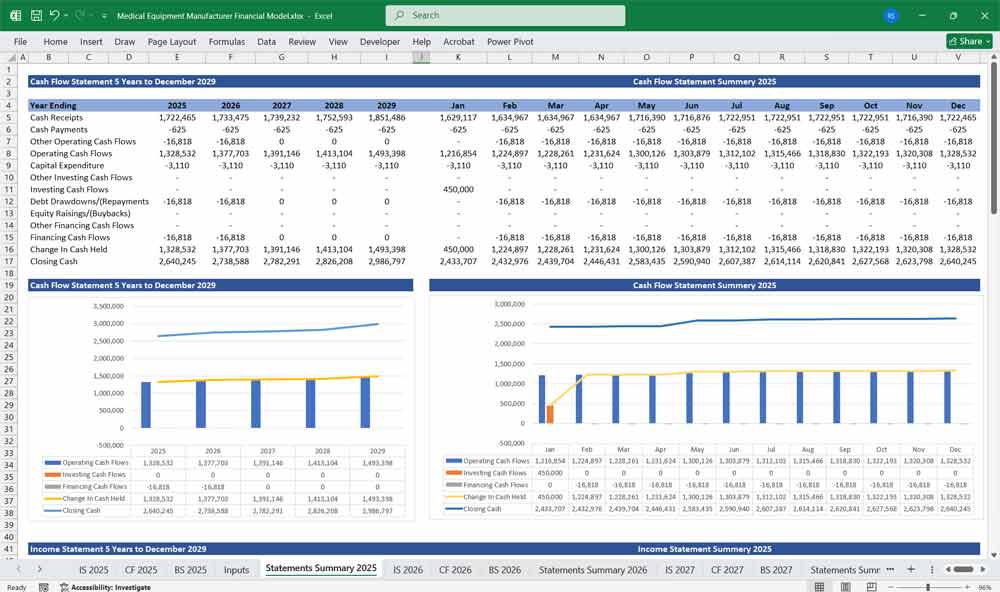
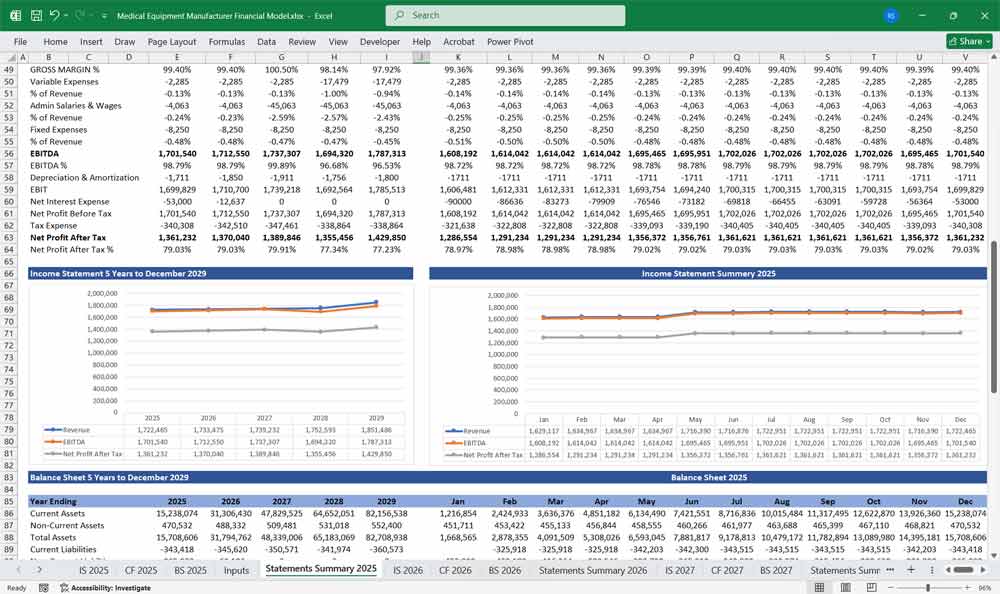
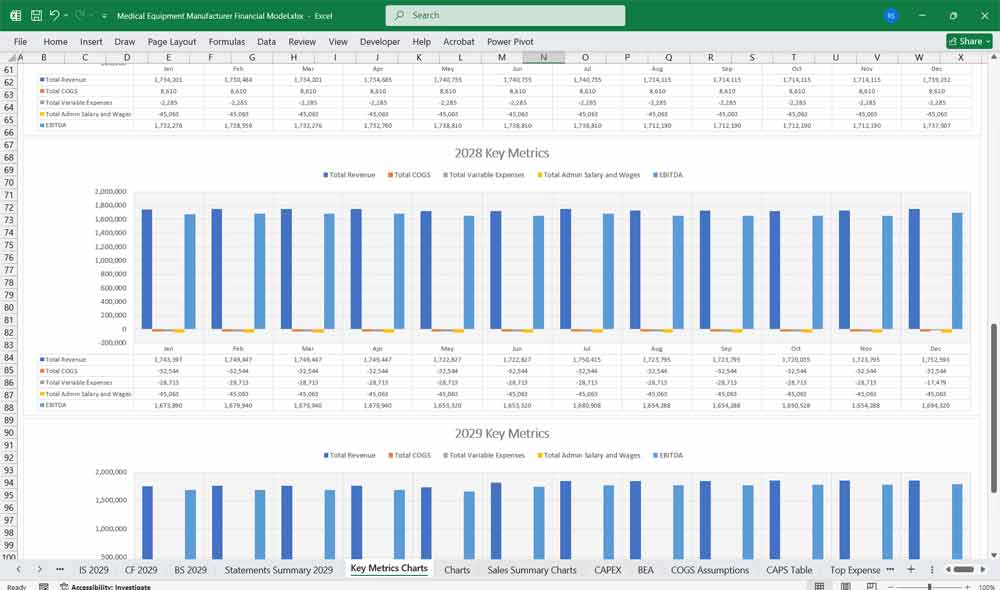
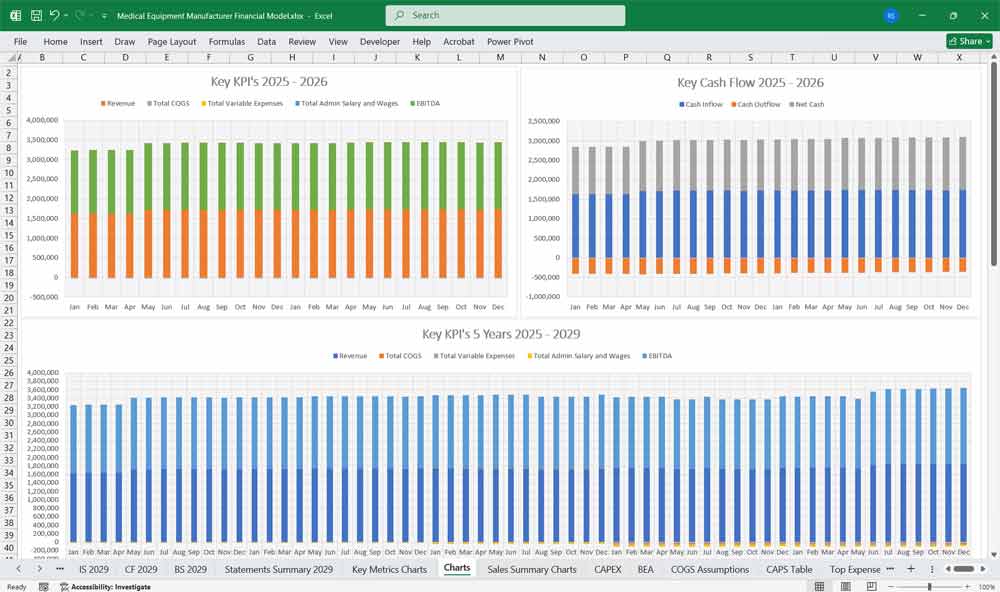
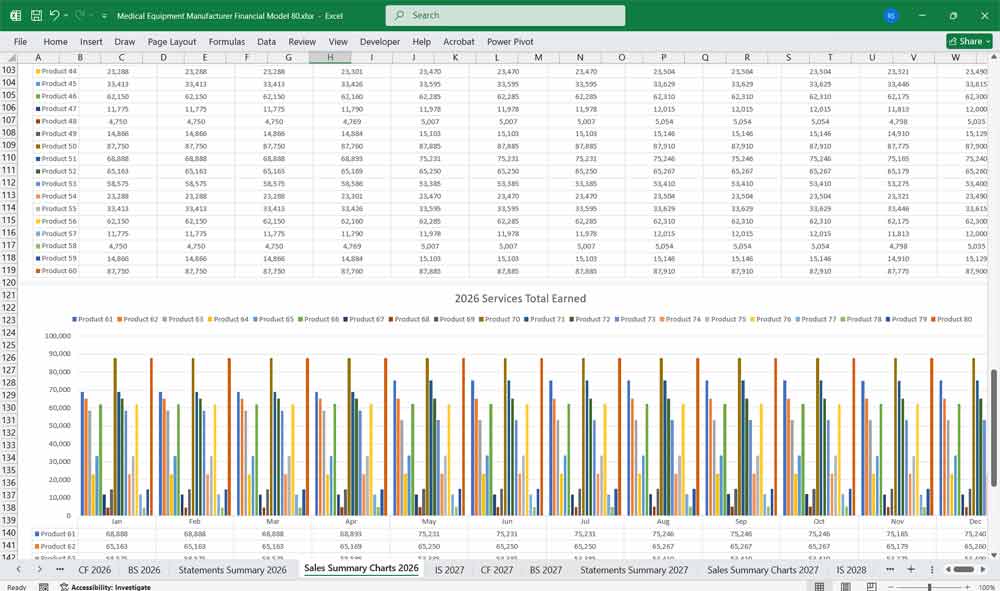
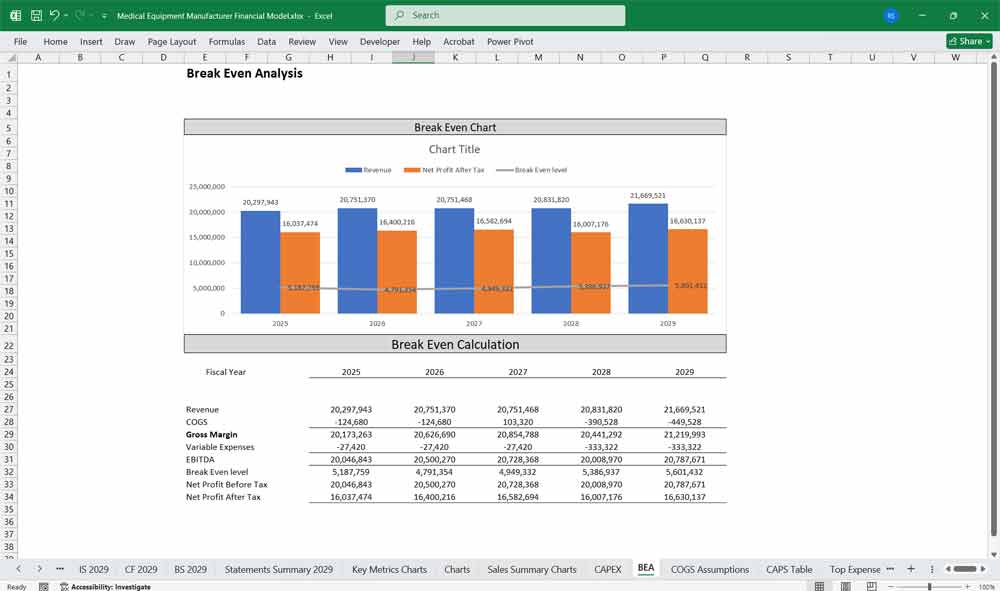
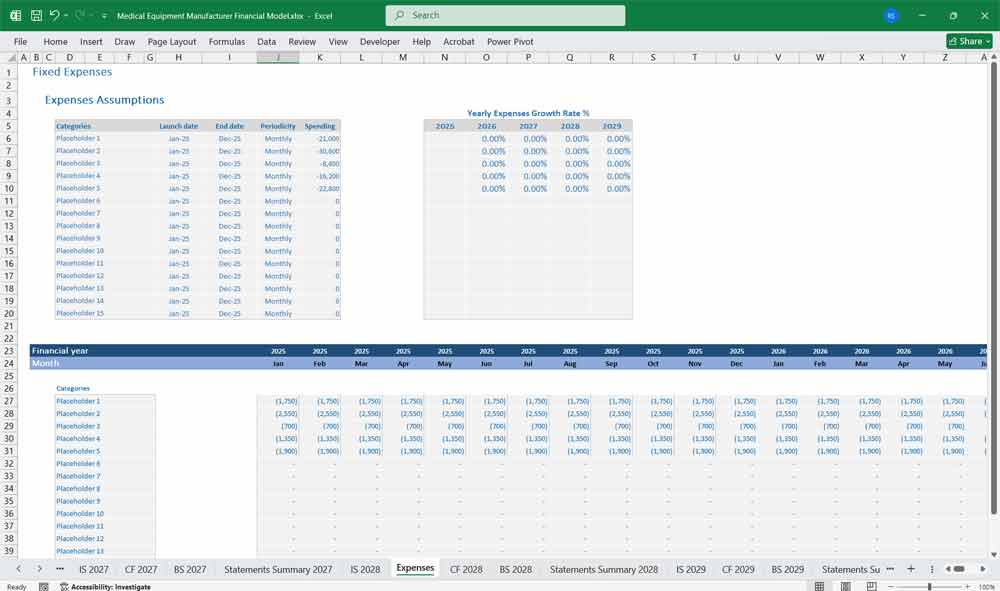
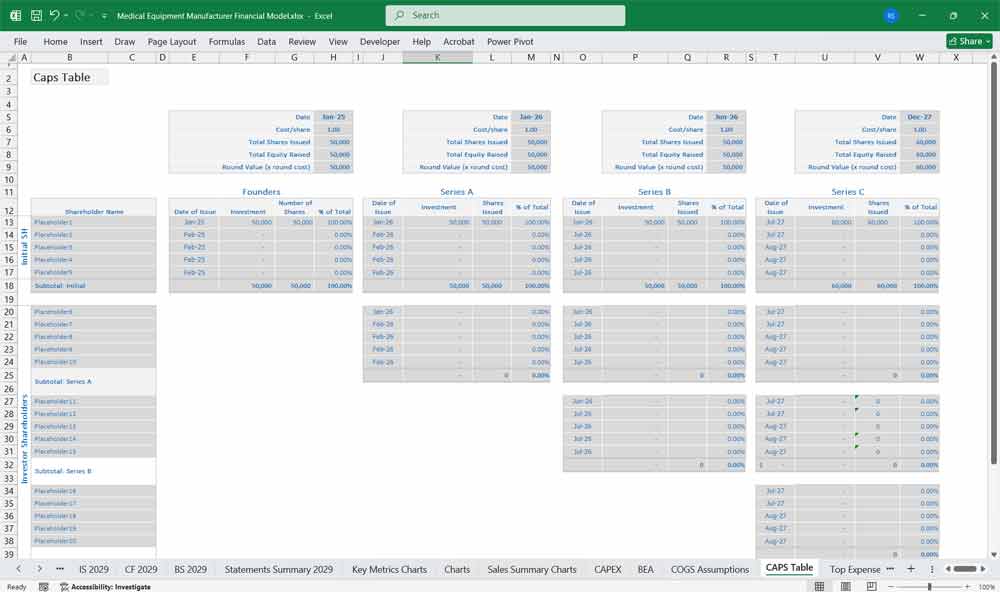
Conclusion on the Financial Model
A financial model for a medical equipment manufacturer provides a detailed framework to forecast revenue, manage expenses, analyze cash flow, and assess financial stability. By incorporating key financial statements and performance metrics, companies can optimize operations, attract investors, and plan for long-term growth.
Download Available Immediately After Payment
Download Available Immediately After Payment
